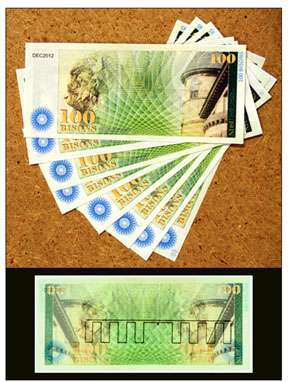Researchers develop 'smart' paper and antennaless RFID tags

Research teams at North Dakota State University, Fargo, have developed a method to embed radio frequency identification (RFID) tags in paper, which could help combat document counterfeiting, and have developed antennaless RFID tags for use on metal. Both teams of researchers are presenting their technology advances at conferences from April 30 to May 2 in Orlando, Fla. Dr. Val Marinov will present research at RFID Journal LIVE! and Cherish Bauer-Reich and Layne Berge are presenting at the Institute of Electrical and Electronics Engineers (IEEE) International Conference on RFID, highlighting the NDSU technology breakthroughs.
Antennaless RFID tags and "smart" paper developed at North Dakota State University are featured at exhibit booth #544 at RFID Journal LIVE!
"Smart" paper
Dr. Val Marinov's team has developed a method to embed ultra-thin, ultra-small RFID chips on paper or other flexible substrates, which could lead to ways to reduce counterfeiting of a wide variety of items such as pharmaceuticals, currency, legal papers, bearer bonds and other security documents. The patent-pending process, known as Laser Enabled Advanced Packaging, uses a laser beam's energy to precisely transfer and assemble chips with dimensions well below those possible using conventional methods.

The embedding method involves chips thinner than most commercial RFID chips on the market today. "We use our LEAP technology to embed ultra-thin, ultra-small semiconductor chips, including 350 µm/side, 20 µm thick semiconductor dice, in paper substrates with a thickness of
RFID-enabled paper could be used to reduce counterfeiting and to improve the tracking of paper documents of all kinds, according to Dr. Marinov. In addition, this method could enable the production of paper-based RFID tags at a cost lower than that of today's conventional RFID tags and at packaging rates multiple times higher than those attainable with the conventional pick-and-place technology. The research has been featured in RFID Journal, as well as in scientific publications.
Antennaless RFID tags
As part of the IEEE International Conference on RFID, Bauer-Reich will discuss research at NDSU's Center for Nanoscale Science and Engineering to develop on-metal RFID tags that use the structure of the tagged object as the antenna. This research has been featured in publications such as RFID Journal, R&D Magazine and Gizmag. Her talk is part of a workshop on Enhancing Near-Metal Performance of RFID.
UHF RFID Antenna for Wireless Sensor Platform
Layne Berge, a graduate student in Electrical and Computer Engineering at NDSU, is presenting a paper titled "A UHF RFID Antenna for a Wireless Sensor Platform with a Near-Isotropic Radiation Pattern," as part of the IEEE conference.
More information: www.rfidjournalevents.com/live/
Provided by North Dakota State University


















